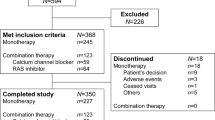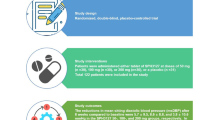Abstract
This multicentre, double-blind, trial in subjects with severe hypertension compared the efficacy and tolerability of two parallel drug regimens: A/B (amlodipine/benazepril: 5/20 or 10/40 mg daily, if necessary) with A (amlodipine: 5 or 10 mg daily, if necessary). The principal dependent variable was the proportion of patients achieving goal blood pressures (BP<140/90 mm Hg or BP<130/80 mm Hg in diabetes or chronic kidney disease) in the two groups within 6 weeks. In the 259 randomized subjects, BP control rates were higher with A/B at 2, 4 and 6 weeks (10.5, 22, and 33.6%, respectively) compared with A (5.7, 16, and 25.8 %, respectively). Corresponding trended BP reductions from baseline at 2, 4 and 6 weeks were about 5 mm Hg greater with A/B (−21±16, −26±17 and −30±17 mm Hg, respectively, compared with A (−16±17, −23±18 and 25±19 mm Hg, respectively, P<0.01). Both regimens were well tolerated; incidences of peripheral oedema at weeks 4 and 6 were similar (A/B: 13 and 20% versus A: 20 and 22%, P=not significant). We conclude that titration of amlodipine and benazepril in single-pill combinations is more effective than titration of amlodipine alone for rapid BP control in patients with severe hypertension.
This is a preview of subscription content, access via your institution
Access options
Subscribe to this journal
Receive 12 digital issues and online access to articles
$119.00 per year
only $9.92 per issue
Buy this article
- Purchase on Springer Link
- Instant access to full article PDF
Prices may be subject to local taxes which are calculated during checkout




Similar content being viewed by others
References
Chobanian AV, Bakris GL, Black HR, Cushman WC, Green LA, Izzo Jr JL et al. Seventh Report of the Joint National Committee on Prevention, Detection, Evaluation, and Treatment of High Blood Pressure. Hypertension 2003; 42: 1206–1252.
Sever P . New hypertension guidelines from the National Institute for Health and Clinical Excellence and the British Hypertension Society. J Renin Angiotensin Aldosterone Syst 2006; 7: 61–63.
Julius S, Weber MA, Kjeldsen SE, McInnes GT, Zanchetti A, Brunner HR et al. The Valsartan Antihypertensive Long-Term Use Evaluation (VALUE) Trial: outcomes in Patients Receiving Monotherapy. Hypertension 2006; 48: 385–391.
The ALLHAT Officers and Coordinators for the ALLHAT Collaborative Research Group. Major outcomes in high-risk hypertensive patients randomized to angiotensin-converting enzyme inhibitor or calcium channel blocker vs diuretic: The Antihypertensive and Lipid-Lowering Treatment to Prevent Heart Attack Trial (ALLHAT). JAMA 2002; 288: 2981–2997.
Jamerson K, Weber MA, Bakris G, Dahlöf B, Pitt B, Shi V et al. Benazepril plus amlodipine or hydrochlorothiazide for hypertension in high-risk patients. N Engl J Med 2008; 359: 2417–2428.
Jamerson KA, Nwose O, Jean-Louis L, Schofield L, Purkayastha D, Baron M . Initial angiotensin-converting enzyme inhibitor/calcium channel blocker combination therapy achieves superior blood pressure control compared with calcium channel blocker monotherapy in patients with stage 2 hypertension. Am J Hypertens 2004; 17: 495–501.
Bakris GL, Weir MR, Study of Hypertension and the Efficacy of Lotrel in Diabetes (SHIELD) Investigators. Achieving goal blood pressure in patients with type 2 diabetes: conventional versus fixed-dose combination approaches. J Clin Hypertens 2003; 5: 202–209.
Weir MR . Incidence of pedal edema formation with dihydropyridine calcium channel blockers: issues and practical significance. J Clin Hypertens 2003; 5: 330–335.
Acknowledgements
This study was supported by Novartis Pharmaceuticals Corporation, East Hanover, NJ, USA. The authors wish to acknowledge the support of all participating physicians. The sponsor was responsible for the design and conduct of the study and the collection of its data and its management. The authors were responsible for the conception and planning of the study, the analysis and interpretation of the data, and the preparation, review and final approval of the paper. The authors wish to thank Novartis employee, Kanaka Sridharan, MS. R.Ph, for provided writing and editorial support. All authors have reviewed and approved the submitted paper.
ClinicalTrials.gov identifier: NCT00136851.
Author information
Authors and Affiliations
Corresponding author
Ethics declarations
Competing interests
JI has received consulting fees from the sponsor. DP, DH and RH are employees of the sponsor.
Rights and permissions
About this article
Cite this article
Izzo, J., Purkayastha, D., Hall, D. et al. Comparative efficacy and safety of amlodipine/benazepril combination therapy and amlodipine monotherapy in severe hypertension. J Hum Hypertens 24, 403–409 (2010). https://doi.org/10.1038/jhh.2009.80
Received:
Revised:
Accepted:
Published:
Issue Date:
DOI: https://doi.org/10.1038/jhh.2009.80
Keywords
This article is cited by
-
Dual role of lipoproteins in endothelial cell dysfunction in atherosclerosis
Cell and Tissue Research (2012)



